To be a great SEO, you need to be able to read a SERP like a book.
With every query comes a unique marketing challenge and opportunity. It’s your job to uncover them and take advantage.
By running SERP analysis, you can determine your challenges and opportunities and devise an SEO plan to get to the top of the results and bring new traffic to your site.
Semrush’s SERP Checker Tools
Semrush offers two free SERP checkers that make SERP analysis easy (sign up for a free trial here).
Keyword Overview—For every keyword in our database, you can analyze the SERP with keyword metrics like search volume, trend, CPC, competition level, keyword difficulty, and more. Position Tracking—For daily rank tracking of a specific list of keywords, you can set up this tool to monitor your SEO position changes on Google. Set the target keywords you want to track to follow your rankings as you move up or down in any location and on any device.What Is SERP Analysis?
SERP analysis is the process of studying a search engine results page to learn why the top-ranking pages are ranking well for the search query.
With a SERP checker tool, SEO professionals can understand the opportunities and difficulties associated with targeting a certain keyword.
How to Analyze a SERP
Analyzing a SERP can be done in many ways for different levels of insight. We’ll walk you through a quick way and a more in-depth way. But first, let’s start with the goals of SERP analysis.
You should run a SERP analysis to:
Understand the level of competition on a keyword’s results page Look for unique opportunities, SERP features, and other rich results that you could target with SEO Decide whether or not a keyword is a reasonable opportunity for your SEO or PPC strategy Brainstorm the unique angle to take with your website’s content that would offer more value to searchers than what’s currently availableAfter a SERP analysis, you can move on to creating a content strategy that will target this keyword based on the unique challenge and opportunity
Quick SERP Analysis: Keyword Overview and Difficulty
The quickest way to analyze the SERP might be to enter the keyword into Semrush’s Keyword Overview report and look for its Keyword Difficulty score. This number tells you how hard it might be to break into this SERP via SEO.
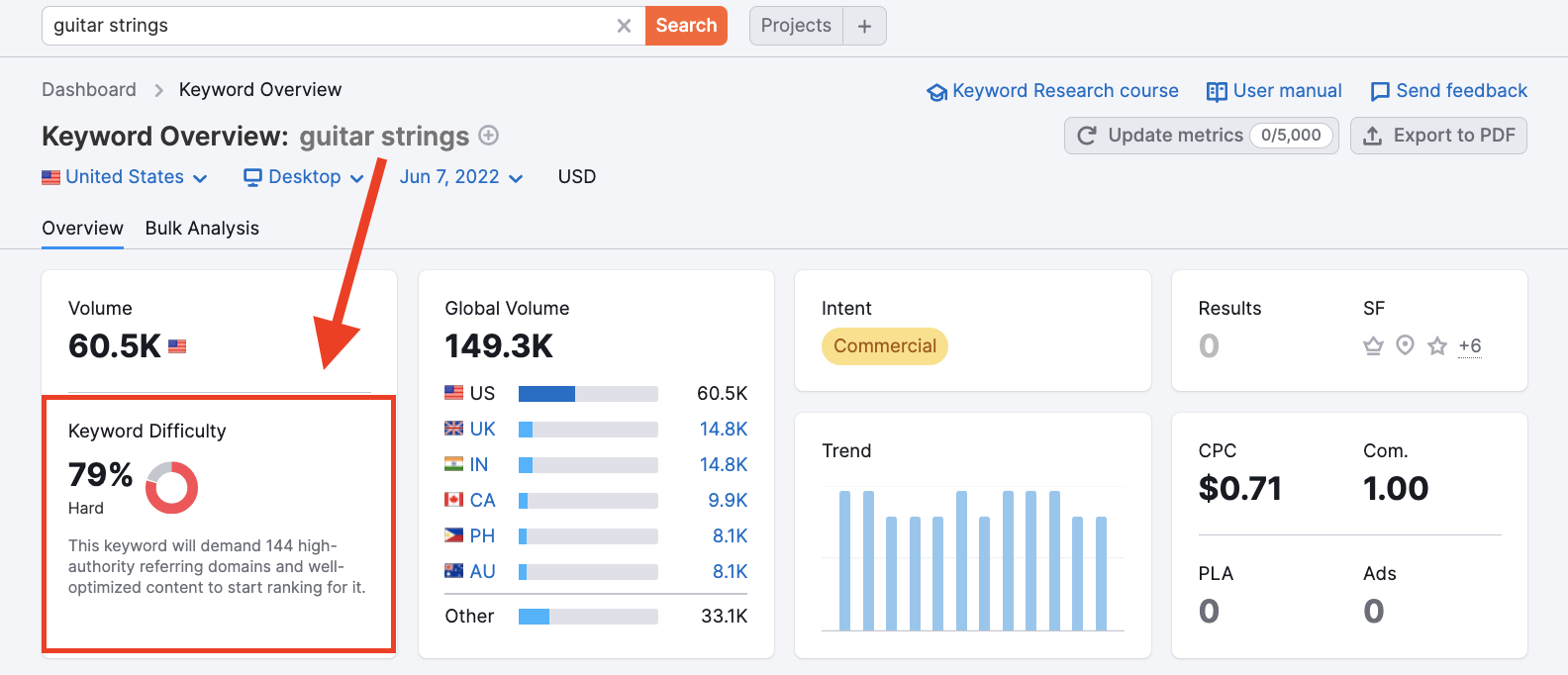 0-14: Very easy 15-29: Easy 30-49: Possible 50-69: Difficult 70-84: Hard 85-100: Very hard
0-14: Very easy 15-29: Easy 30-49: Possible 50-69: Difficult 70-84: Hard 85-100: Very hardThen, scroll down in this report to see the actual list of organic search results for the query.
Here’s what the SERP Analysis widget looks like for “guitar strings.”
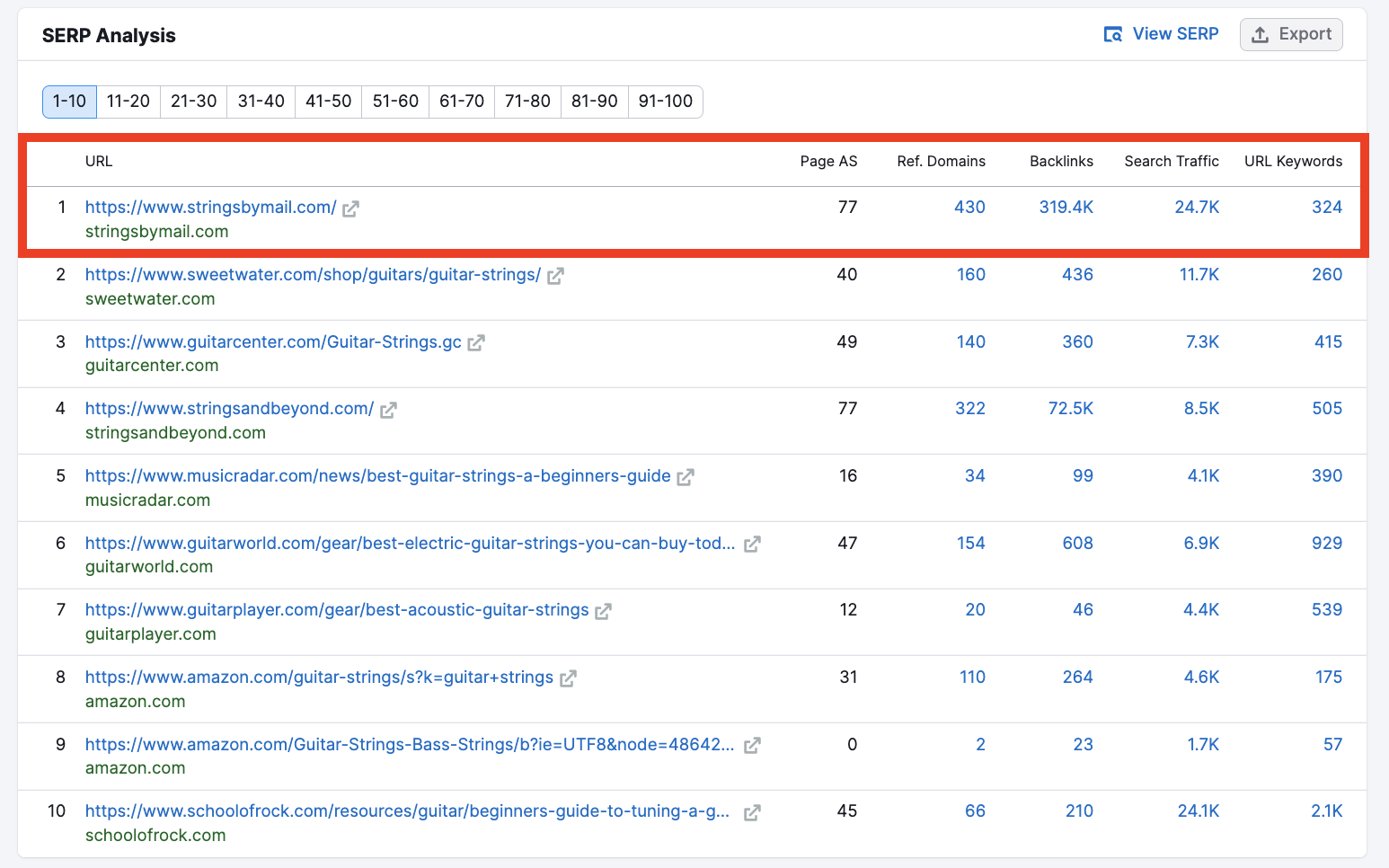
This part of the report gives you a quick overview of your SERP competitors. The columns show how strong their SEO might be based on:
Authority Score of each page Total referring domains pointing to each page Total backlinks pointing to each page Estimated monthly organic search traffic to each page How many total keywords the URLs also rank for in Google’s top 100 resultsWhile the screenshot above shows a “hard” SERP with a KD% score of 79%, the screenshot below shows a “very easy” SERP with a KD% score of 14%.
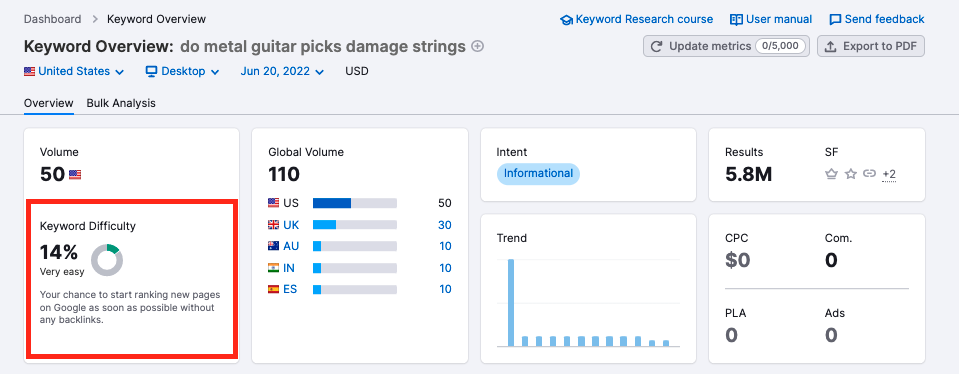
Here’s what the SERP Analysis widget looks like for “do metal guitar picks damage strings.”

Notice the difference?
We can see that 5 pages on this first page of Google have 0 backlinks. The top result, which holds a featured snippet, only has 1 backlink.
That’s possible because this SERP is for a long-tail low-competition keyword (do metal guitar picks damage strings), making it an easier opportunity to rank with SEO.
Quick Tip: You can also view a mini Keyword Overview report to check SERP Analysis if you’re viewing an Organic Positions report, Keyword Magic Tool report, or any keyword-based report by clicking on these >> arrows next to the keyword (watch below)
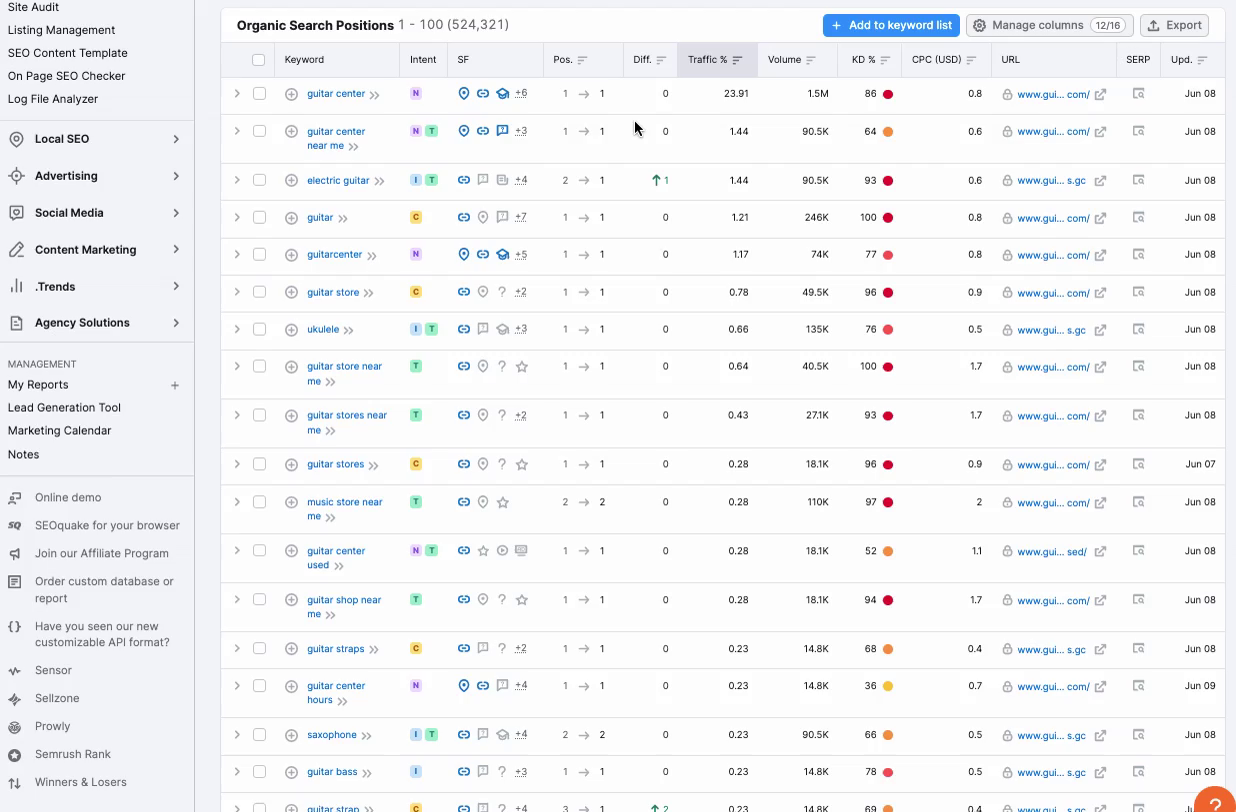
Using Position Tracking as a Daily Local SERP Checker
To check SERPs for your website’s target keywords daily, you can use the Semrush Position Tracking tool.
This tool gives you reports and dashboards to benchmark your website’s SERP visibility against the competition.

Check SERP versions across desktop, mobile, and tablet for any geographic location.
For every keyword you’re tracking, you can analyze the intent, competition, and SERP features.
You can click “View SERP” to open up a snapshot of the results page as Semrush saw it to inspect the SERP further.
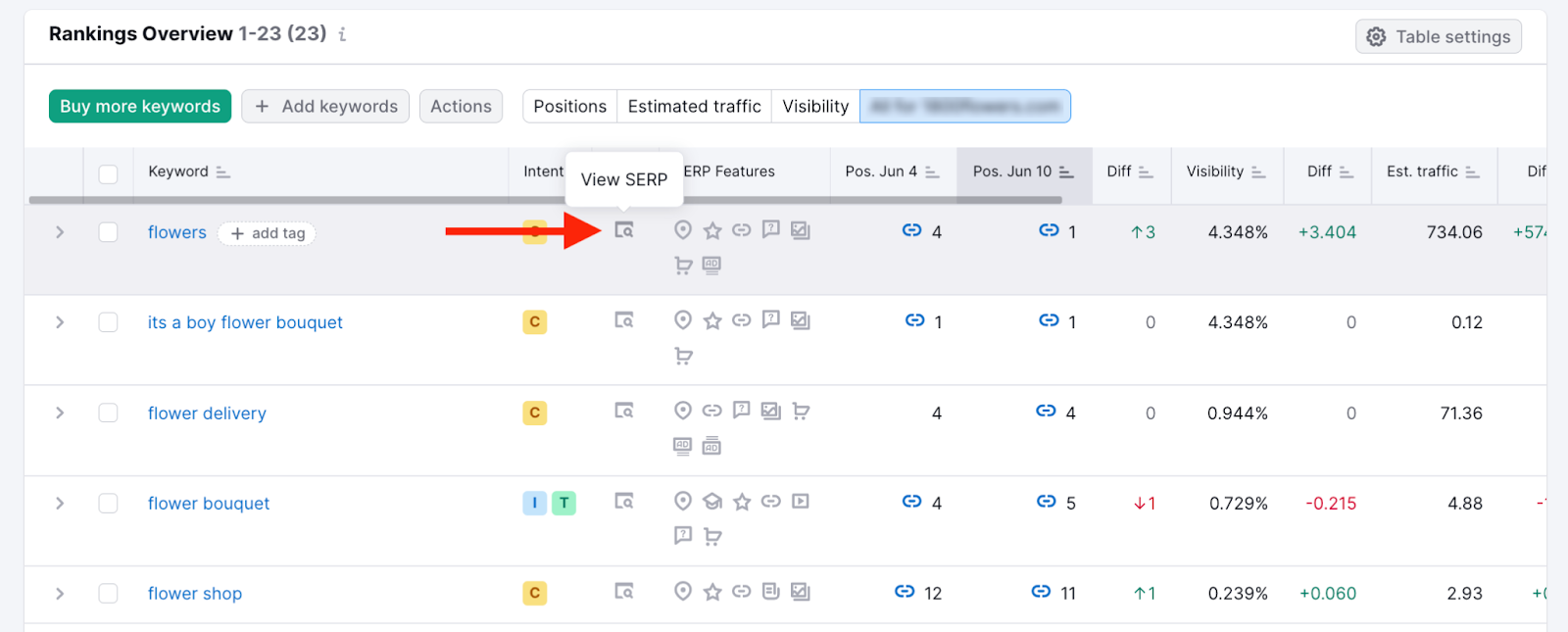
This allows you to continually check the SERPs that are most important to your business.
In-depth SERP Analysis: Studying Content and SERP Features
Now, to dive deeper into the search results, you’ll want to study:
The search intent of the query The presence of featured snippets and rich results If this is a local SEO or non-local specific search Your rivals’ competitive positioningSearch Intent
Understanding search intent is critical to SEO. People use search for a million reasons—to shop, to study, to find entertainment, to look up the capital of North Dakota—the list goes on.
The better you know your searcher’s intent behind each keyword, the better you can meet their intent with your content strategy.
On Semrush, you can immediately see any keyword’s intent with the dedicated column in every keyword-based report. We bucket intent into four main types:
Informational keywords—searchers looking for an answer to a specific question or general information Navigational keywords—searchers intending to find a specific site or page Commercial keywords—searchers looking to investigate brands or services Transactional keywords—searchers intending to complete an action or purchaseWhen you enter a keyword into Keyword Overview, you can see which bucket it falls into at the top of the report.
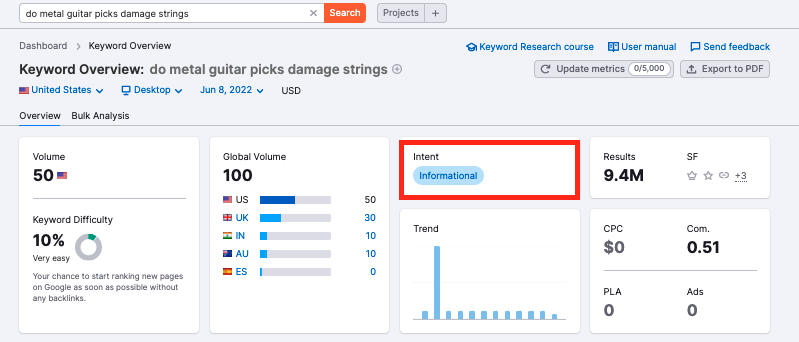
When you know what the intent of the SERP is, it can inform your content strategy.
For informational searches, your goal should be to educate. For navigational searches, your goal should be to direct people to the right place. For commercial searches, your goal should be to help people make an informed shopping decision. For transactional searches, your goal should be to offer a seamless way to make a transaction (purchase, download, sign-up, etc.).Presence of SERP Features
Next, you can look deeper into the rich results and SERP features Google puts on the first page.
These special results Google chooses to show can tell you about what kind of content the algorithm believes the searcher is looking for.
Example 1
For example, here’s the top of a SERP for the commercial keyword, “best bluegrass guitar strings.”
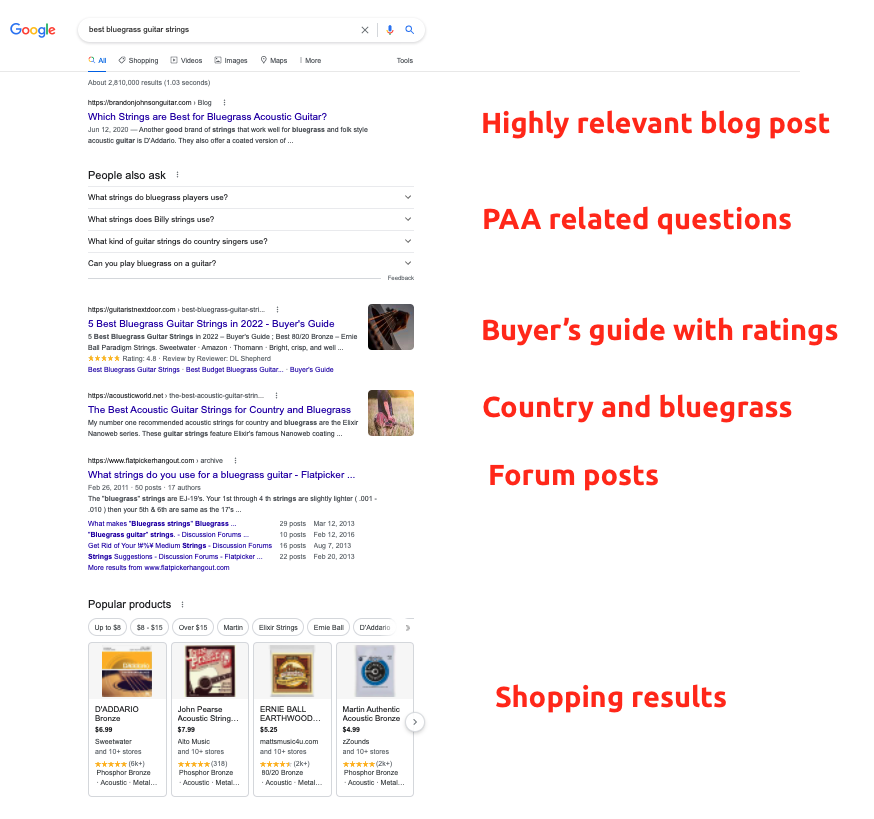
We can see that Google is trying to give searchers options with various types of content—blog posts, related questions, buying guides, forums, and product ads are all on the first page.
What this tells us is that Google thinks the searcher wants to find information related to making a purchase soon.
So, if you were to target this keyword, you’d want to create content on your site that has a little bit of everything on this SERP (and more) to help people decide on what guitar strings to purchase for bluegrass music.
Sure enough, the content from the top “People also ask” question also comes from the first organic result on the SERP.
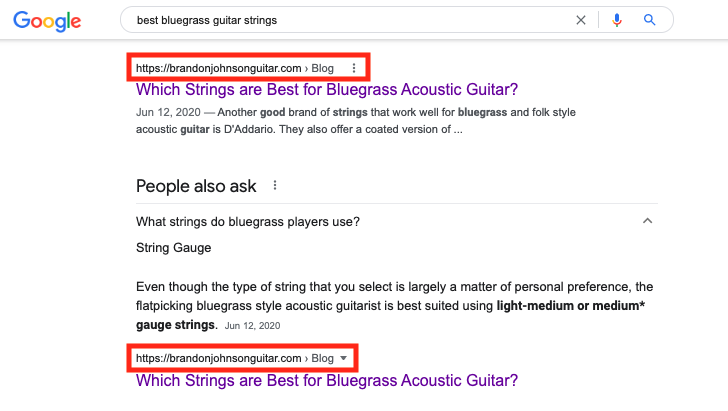
Example 2
If we look at another keyword, “guitar strings labeled,” we can see that the first plain organic result is all the way at the bottom of the first page, below a featured snippet, image block, and people also ask block.
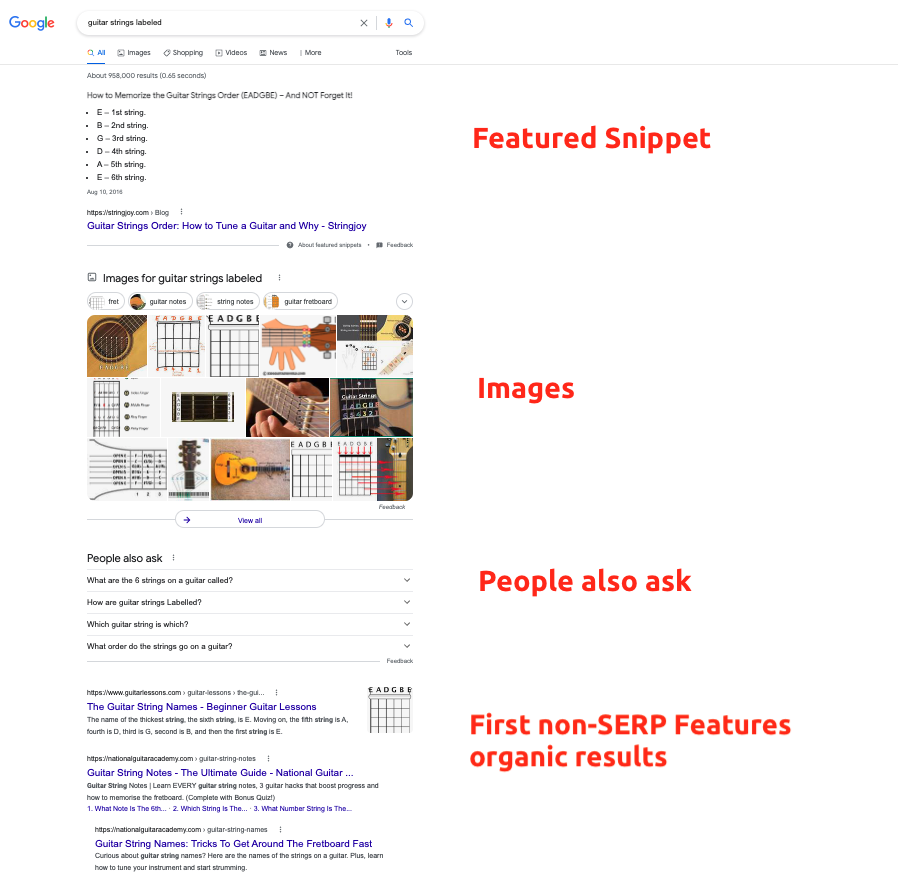
So, the challenge and opportunity to rank on this SERP would be a bit different from the one above. To get visibility on this SERP, you’d want to include optimized images that answer the searcher's intent—to see a picture of guitar strings labeled.
In addition, you’d want to focus your content on answering the people also ask questions, and format your content with a list to target the featured snippet.
Local Intent
Another type of intent to analyze on a SERP is if the query is location-based. This is pretty easy to spot by the presence of local packs on the SERP.
Local pack = local intent.
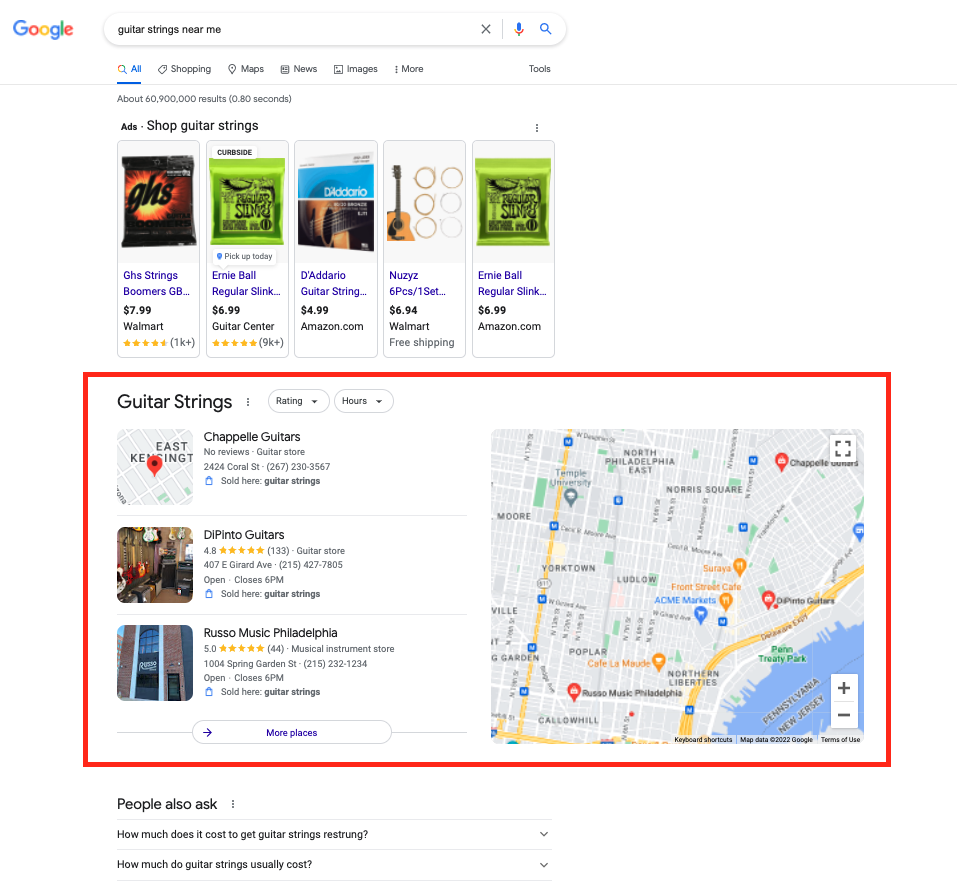
If your business operates locally, then you should definitely try to optimize your local visibility for any SERPs with local intent.
SERP Competitive Analysis
Lastly, and perhaps most importantly, comes the competitive analysis of a SERP. This consists of:
Identifying your rivals’ successful strategies/positioning Understanding the level of competition—how hard it will be to take the top position Coming up with your own unique selling proposition (USP)Rather than diving into a full SEO competitive analysis of all of your rivals, you just need to look at the top results on this SERP and come up with a plan to separate your website from the pack.
BONUS: Oftentimes those top results are not owned by direct competitors, but trusted publisher sites and blogs. If they're ranking for your keywords, and especially if they mention your competitors but not you, you should reach out and see if they'll add you. A tool like Surround Sound makes it easy to spot any opportunities for more SERP coverage, track your progress, and showcase your results.
While keyword difficulty does a good job of summarizing a SERP’s competition level, you can also look at all of the page titles on the SERP to see each competitor’s angle.
Writing a compelling and unique page title is just one tactic to stand out on the SERP.

To help your content stand out, you’ll need to follow SEO best practices, which include writing compelling titles and descriptions, optimizing internal links, and creating useful content.
Five quick tips that could make your content more useful than the current competitors:
Having a compelling and unique title Gathering original data Including custom visuals Making it easier to read Making it easier to shareAny of these five angles could be the unique selling proposition that helps your content stand out.
What’s a Unique Selling Proposition?
Your unique selling proposition is what makes your product or service stand out from the rest.
It’s not just what you’re saying on your website/blog/video, but it’s why it matters to the person you’re trying to reach.
To find your USP in SEO, think about your strengths and how they’re different from your SERP competitors. Or, exploit a competitor’s weakness.
Strengths and weaknesses in SEO could be a lot of different things. Your Authority Score could be higher than what’s currently on the first page—that would be a strength of yours. If you have more expertise and can provide more in-depth, informed content, that would also be a strength. Then, tie it all into why your strength matters to your audience.
Can you provide the best visual content that addresses the search intent? That could also be a strength, and therefore a USP to help you get to the top.
Next Step: Content Strategy
If you haven’t already, sign up for a free Semrush subscription to gain access to our Keyword Overview and Position Tracking tools.
These tools will allow you to:
Study the competition level of any keyword’s SERP Identify SERP features and rich results to target with SEO Come up with a USP to position your website Follow daily changes across desktop, mobile, and tablet SERPs in any locationYou can also check out the Semrush Sensor tool to follow SERP volatility in any major industry or for a set of target keywords.
With a smart method of SERP analysis, you can take your keyword research and build the perfect content strategy to start getting organic traffic.
Innovative SEO services
SEO is a patience game; no secret there. We`ll work with you to develop a Search strategy focused on producing increased traffic rankings in as early as 3-months.
A proven Allinclusive. SEO services for measuring, executing, and optimizing for Search Engine success. We say what we do and do what we say.
Our company as Semrush Agency Partner has designed a search engine optimization service that is both ethical and result-driven. We use the latest tools, strategies, and trends to help you move up in the search engines for the right keywords to get noticed by the right audience.
Today, you can schedule a Discovery call with us about your company needs.
Source:





